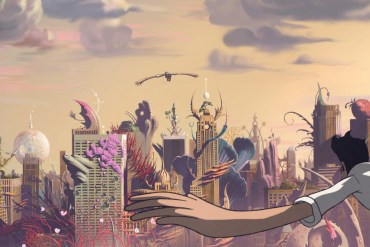Fevers are dangerously useful tools, in storytelling as in human biology. The same way they overheat the body to exterminate undesired pathogens, a narrative fever can melt away the vices accumulates in decades of genre cinema, franchise-building and Hollywood homogenization. In physics, heat is created by the random oscillation of atoms. In storytelling, this would be the introduction of something outlandishly arbitrary, absurd and random to the point of creating humor and unexpected twists. However, a careless flirt with heat can as easily kill the patient. To enrich the same old archetypes with illogicality and mystery is a formidable challenge: stirring up magic maintaining clarity is the kind of trick only master con-artists can pull off.
Ari Folman is one of those magicians. The Israeli director gained international fame in 2008 with Waltz with Bashir, a rotoscoped animation on his experience as a soldier during the Lebanese Civil War. The alienating style, of a not-quite-human and uncanny quality, merged perfectly with the narrative uncertainty of the protagonist’s struggle to remember his year’s under arms. Conflicts are usually the epitome of certainty, with both sides asserting a monopoly over truth and over their right to victory. Waltz reflected these facts back to the audience, like a deforming mirror, enhancing and highlighting how rhetorics can give birth to the contradictory, irremediably inconsistent bestiality of war.
A similar approach had been taken in the 1970s by Polish science fiction writer Stanislaw Lem, author of novels like Solaris and Cyberiad. Like many fellow writers beyond the Iron Curtain, Lem regularly clashed with censors, who feared his works could set a dangerous precedent, namely that of criticizing the Polish regime by hiding political positions with interstellar camouflage. His novels, to be fair, often offer much room to satirize his homeland: characters are often grotesquely obtuse, powerful people deceitful. Like Folman’s work decades later, Lem had a tendency to channel the alienation of his plots through his narrative style.
His prose was precise, but its precision only amplified unreliable narration, uncertainty over the unfolding story and a looming sense that something is wrong. The Futurological Congress is novel most engaged in this approach. The plot is convoluted enough. The protagonist Iljon Tichy attends a global congress of futurologists (a profession consisting in predicting the future, something common then as now), held in a Hilton hotel with “Bomb-free rooms” and a “all-girl orchestra [that] played Bach while performing a cleverly choreographed striptease“. Our hero suddenly finds itself in the midst of a revolution, which the government tries to suppress by putting a psychotropic “benevolent drug” in the public water supply. After the hotel is bombed to smithereens, Iljon is reanimated in a far-off future, when the whole world is controlled and ruled through the use of hallucinogenic drugs and feel-good pills. He finally rebels, discovering the desolate state of the true world, and perishes at the behest of the ruling dictator.
The bizarre novel is considered a classic but is mostly remembered for the premise of its second part. Like the Matrix did in 1999, it touches upon a series of anxieties towards the new silver bullet said to be able to solve all of the world’s problems: then it was chemistry, today the digital revolution. However, it’s the alienating atmosphere that accompanies this idea that really makes Lem’s work one of a kind. A truly faithful adaptation would have thus been an impossible task: how to transmit the discomfort typical of a certain historical period? More importantly, how to translate the state of lucid dream certain prose can create to the big screen? Folman’s attempt, “The Congress“, comes very close to transmitting those same qualities, by choosing to change everything in order to preserve the original atmosphere for modern audiences. The first part of the movie follows the sad existence of an alternate-universe version of Robin Wright (played by… well, Robin Wright), whose career has been plagued by bad decisions and has never taken off after The Princess Bride (1987). Her agent (Harvey Keitel) arranges an appointment with a massive film studio, a not-so-subtle Disney reference, to have her image digitally captured and used for future movies. She will never be able to act again, but her likeness will generate her a steady flow of royalties which she can use to cure her ill son. After the first resistances, she gives in. After some years, she is invited to a massive event by Definitely-not-Disney, held in a “Animation Zone” in the desert, where retired actors and producers live in a state of constant hallucination.
Fast forward a few years, and the whole world is experiencing life through the filters of a pill-induced animated reality. After seeing the movie after a couple of years, it’s sadly unsettling to see how much it got right regarding the direction the cinematic industry - and us outside of it - have decided to go. The mind jumps to the latest events in Hollywood affairs. which line up almost perfectly with the events of the movie: Peter Cushing’s digital resurrection in Star Wars: Rogue One, the almost-monopoly of Disney over the entertainment industry, the constant search for new ways to monetize imagination (“When you fantasize alone in the dark, do you pay him or her royalties? […] That’s what we’re going for”). But there are also subtler ways with which Folman indicts public and producers alike. Actors are robbed of any agency, and their characters come to life walking around the world with their likenesses, in a way which eerily reminds the Internet’s tendency to conflate figures in media with the people behind the mask. The entire entertainment world (and why not, also the political one) has abdicated the role of stirring emotions and wonder in its public, selling them only the instruments to do so on their own (“Be your own dream, for God’s sake!”).
Most importantly, the desperate search for happiness and fulfillment has made individuality almost impossible in a world of shape-shifters and where the pop culture has imposed itself like a rigid canon of what people should love. In these conditions, intimacy is all but dead, buried under layers of animations. Unlike other dark prophecies, The Congress uses absurdist humor to distract from the criticized objects and let the public focus on what we risk losing going down this path. Where pure high-brow satire nails the audience to a game of spotting the differences (I’m looking at you, The Dictator and Ready Player One), Folman makes the basic premise so confused and absurdly convoluted that it doesn’t subtract from the personal stories unfolding in the foreground. For this, we can probably thank the resuscitated cartoon of Lem.
To help us continue to create content, please consider supporting us on Patreon: https://www.patreon.com/filmera.


